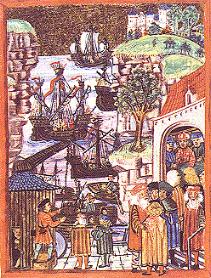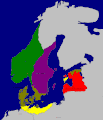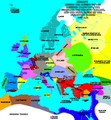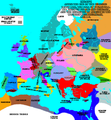Hanseatic League
- This article is about the historical concept. For the modern, please see Hanseatic Parliament

The Hanseatic League was an alliance of trading guilds that established and maintained a trade monopoly over the Baltic Sea, to a certain extent the North Sea, and most of Northern Europe for a time in the Late Middle Ages and the early modern period, between the 13th and 17th centuries.
History
Historians generally trace the origins of the League to the foundation of the Northern German town of Lübeck, established in 1158/1159 after the capture of the area from the Count of Schauenburg and Holstein by Henry the Lion, the Duke of Saxony.
Exploratory trading adventures, raids and piracy had occurred earlier throughout the Baltic (see Vikings) — the sailors of Gotland sailed up rivers as far away as Novgorod, for example — but the scale of international economy in the Baltic area remained insignificant before the growth of the Hanseatic League.
German cities achieved domination of trade in the Baltic with striking speed over the next century, and Lübeck became a central node in all the sea-borne trade that linked the areas around the North Sea and the Baltic Sea. The 15th century saw the climax of Lübeck's hegemony. (Visby, one of the midwives of the Hanseatic league in 1358, declined to become a member. Visby dominated trade in the Baltic before the Hanseatic league, and with its monopolistic ideology, suppressed the Gotlandic free-trade competition.)
Foundation

Lübeck became a base for merchants from Saxony and Westphalia to spread east and north. Well before the term Hanse appeared in a document (1267), merchants in a given city began to form guilds or Hansa with the intention of trading with towns overseas, especially in the less-developed eastern Baltic area, a source of timber, wax, amber, resins, furs, even rye and wheat brought down on barges from the hinterland to port markets.
Visby functioned as the leading centre in the Baltic before the Hansa. For 100 years the Germans sailed under the Gotlandic flag to Novgorod. Sailing east, Visby merchants established a branch at Novgorod. To begin with the Germans used the Gotlandic Gutagard. With the influx of too many merchants the Gotlanders arranged their own trading stations for the German Petershof further up from the river — see a translation of the grant[1] of privileges to merchants in 1229. They expanded former Slavic towns and helped establish new German towns into key Hansa towns on and near the east Baltic coast: Danzig (Gdańsk), Elbing (Elblag), Thorn (Toruń), Reval (Tallinn), Riga and Dorpat (Tartu), all founded (like others on the Baltic coast) under Lübeck law, which provided that they had to appeal in all legal matters to Lübeck's city council. Before the foundation of the Hanseatic league in 1358 the word Hanse did not occur in the Baltic. The Gotlanders used the word varjag.
Hansa societies worked to acquire special trade privileges for their members. For example, the merchants of the Cologne (Köln) Hansa contrived to convince Henry II of England to grant them (in 1157) special trading privileges and market rights which freed them from all London tolls and allowed them to trade at fairs throughout England. The "Queen of the Hansa", Lübeck, where traders trans-shipped goods between the North Sea and the Baltic, gained the Imperial privilege of becoming an Imperial city in 1227, the only such city east of the River Elbe.
Lübeck, which had access to the Baltic and North Sea fishing grounds, formed an alliance in 1241 with Hamburg, another trading city, which controlled access to salt-trade routes from Lüneburg. The allied cities gained control over most of the salt-fish trade, especially the Scania Market; and Cologne joined them in the Diet of 1260. In 1266 Henry III of England granted the Lübeck and Hamburg Hansa a charter for operations in England, and the Cologne Hansa joined them in 1282 to form the most powerful Hanseatic colony in London. Much of the drive for this co-operation came from the fragmented nature of existing territorial government, which failed to provide security for trade. Over the next 50 years the Hansa itself emerged with formal agreements for confederation and co-operation covering the west and east trade routes. The chief city and linchpin remained Lübeck; with the first general Diet of the Hansa held there in 1356, the Hanseatic League acquired an official structure and could date its official founding.
Expansion

Lübeck's location on the Baltic provided access for trade with Scandinavia and Russia, putting it in direct competition with the Scandinavians who had previously controlled most of the Baltic trade routes. A treaty with the Visby Hansa put an end to competition: through this treaty the Lübeck merchants also gained access to the inland Russian port of Novgorod, where they built a trading post or Kontor. Other such alliances formed throughout the Holy Roman Empire. The League never became a closely-managed formal organisation. Assemblies of the Hanseatic Towns met irregularly in Lübeck for Hansetag, from 1356 onwards, but many towns chose not to send representatives and decisions did not bind individual cities. Over time, the network of alliances grew to include a flexible roster of 70 to 170 cities [2].
The league succeeded in establishing additional Kontors in Bruges (in the County of Flanders, present-day Belgium), Bergen (Norway), Copenhagen (Denmark) and London (England). These trading posts became significant enclaves. The London Kontor, established in 1320, stood west of London Bridge near Upper Thames Street. (Cannon Street station occupies the site now.) It grew significantly over time into a walled community with its own warehouses, weighhouse, church, offices and houses, reflecting the importance and scale of the activity carried on. The first reference to it as the Steelyard (der Stahlhof) occurs in 1422. In addition to the major Kontors, individual ports had a representative merchant and warehouse. In England this happened in Boston, Bristol, Bishop's Lynn (now King's Lynn, which features the sole remaining Hanseatic warehouse in England), Hull, Ipswich, Norwich, Yarmouth and York.
The League primarily traded timber, furs, resin (or tar), flax, honey, wheat and rye from the east to Flanders and England with cloth (and, increasingly, manufactured goods) going in the other direction. Metal ore (principally copper and iron) and herring came southwards from Sweden.

German colonists under strict Hansa supervision built numerous Hansa cities in the Baltic: towns like Reval (Tallinn), Riga, and Dorpat (Tartu), some of which still retain many Hansa buildings and bear the style of their Hanseatic days. Livonia (presently Estonia and Latvia) had its own Hanseatic parliament (diet), and all of its major towns became members of the Hanseatic League. The dominant language of trade was Mittelniederdeutsch Middle Low German, a language with significant impact for countries involved in the trade, particularly the larger Scandinavian languages.
Zenith
Danzig (Gdańsk), along with other important Hansa cities including Thorn (Toruń) and Elbing (Elbląg) was incorporated into Poland at the Second Treaty of Toruń in 1466. Cracow, then the capital of Poland, was also a Hansa city. The lack of customs borders on Vistula river after 1466 helped to gradually increase Polish grain export, transported to the sea port down Vistula, from 10,000 t per year in late 15th century to over 200,000 t in 17th century[3]. The Hansa dominated maritime grain trade made Poland one of the main areas of its activity helping Danzig to become Hansa's largest city due to its control of the Poland grain export.


The League had a fluid structure, but its members shared some traits. First, most of the Hanseatic League (or Hansa) cities either started as independent cities or gained independence through the collective bargaining power of the League. Such independence remained, however, limited; it meant that the Hansa cities in Germany owed allegiance directly to the Emperor of the day, without any intermediate tie to the local nobility. Another similarity involved the cities' strategic locations along trade routes. In fact, at the height of its power in the late 1300s, the merchants of the Hanseatic League succeeded in using their economic clout (and sometimes their military might - trade routes needed protecting, and the League's ships sailed well-armed) to influence Imperial policy.
The League also wielded power abroad: between 1368 and 1370, Hansa ships fought against the Danes, and forced King Valdemar IV of Denmark to grant the League 15 percent of the profits from Danish trade (Treaty of Stralsund, 1370) and an effective trade monopoly in Scandinavia. The Hansa also waged a vigorous campaign against pirates. Between 1392 and 1440 maritime trade of the League faced danger from raids of the Victual Brothers and their descendants, a mighty brotherhood of privateers hired in 1392 by Albrecht of Mecklenburg against the Danish queen Margaret I. In the Dutch-Hanseatic War (1438 — 1441) the merchants of Amsterdam sought and eventually won free access to the Baltic and broke the Hansa monopoly. As an essential part of protecting their investment in trade and ships, the League trained pilots and erected lighthouses.
Exclusive trade routes often came at a high price. Most foreign cities confined the Hansa traders to certain trading areas and to their own trading posts. They could seldom, if ever, interact with the local inhabitants, except in the matter of actual negotiation. Moreover, many people, merchant and noble alike, envied the power of the League. For example, in London the local merchants exerted continuing pressure for the revocation of the privileges of the Hanseatic League. The refusal of the League to offer reciprocal arrangements to their English counterparts exacerbated this tension. King Edward IV of England reconfirmed the league's privileges in 1474 despite this hostility — in part at least thanks to the significant financial contribution the League made to the Yorkist side during The Wars of the Roses. A century later, in 1597, Queen Elizabeth I expelled the League from London and the Steelyard closed in 1598. The very existence of the League and its privileges and monopolies created economic and social tensions that often crept over into rivalry between League members.
Downfall
The economic crises of the late 14th century did not spare the Hansa. Nevertheless, its eventual rivals emerged in the form of the territorial states, whether new or revived, and not just in the west: Poland triumphed over the Teutonic Knights in 1466; Ivan III of Russia ended the entrepreneurial independence of Novgorod in 1478. New vehicles of credit imported from Italy outpaced the Hansa economy, in which silver coin changed hands rather than bills of exchange.
In the 14th century, tensions between Prussia and the Wendish cities (Lübeck and neighbours) rose. Lübeck was dependent on its role as centre of the Hansa, being on the shore of the sea without a major river. Lübeck was on the entrance of the land route to Hamburg, but this land route could be circumvented by the sea travel around Denmark and through the Sound. Prussia's main interest on the other hand was primarily of exporting bulk products like grain and timber, which were very important for England, the Low Countries and later on also for Spain and Italy.
A major benefit for the Hansa was its domination of the ship-building market, mainly in Lübeck and in the Prussian city of Danzig. The Hansa sold ships everywhere in Europe including Italy. The Hansa had excluded the Hollanders from the Hansa, because it wanted to favour Bruges as a huge staple market at the end of a trade route. The Hollanders regarded themselves as Germans and were part of the same German Empire as Lübeck, still they weren't allowed to be part of the German Hansa. When the Hollanders started to become competitors of the Hansa in ship-building, the Hansa tried to stop the flow of ship-building technology from Hansa towns to Holland. Prussian Danzig didn't feel for it and tried to stall the decision. Hollandish ships sailed to Prussia to take grain from the Prussians directly, to the dismay of Lübeck. The staple market from Bruges was moved to Antwerp. Bruges, Antwerp and Holland all became part of the same country, Burgundy which actively tried to take over the monopoly of trade from the Hansa. The power of the Hansa was broken when Hollanders and Prussians became trading partners and didn't care anymore about Lübeck except for ending its position as a leading trading town.
Hollanders circumvented the Hansa towns by trading directly with North German princes in non-Hansa towns. Hollandish freight costs were much lower than those of the Hansa and the hansa were excluded as middlemen. Nürnberg developed an overland route of formally Hansa products from Frankfurst via Nürnberg and Leipzig to Poland and Russia, trading Flemish cloth and French wine in exchange for grain and furs from the east. The Hansa could only profit from the Nürnberg trade by allowing Nürnbergers to settle in Hansa towns, which the Nürnbergers exploited by taking over trade with Sweden as well.
In 1466, the Western Prussian towns rose against the dominance of the Teutonic Order and asked for help of the Polish king. Danzig, Thorn and Kulm became loyally German speaking citizens of Poland who traded with the Dutch. The famous Copernicus lived in those days in Thorn. [unbalanced opinion?]
The Dutch merchants aggressively challenged the Hansa and met with success. The Hansa cities of Prussia, Livonia and Poland supported the Netherlands against the main cities of the Hansa in northern Germany. After several naval wars between the Burgundian and the Hanseatic fleets, Amsterdam became the leading port for Polish and Baltic grain from the late 15th century onwards. The Dutch regarded grain trade of Amsterdam as the mother of all trades (Moedernegotie). Denmark and England tried to destroy the Netherlands in the early 16th century, but failed.
At the start of the 16th century the League found itself in a weaker position than it had known for many years. The rising Swedish Empire had taken control of much of the Baltic. Denmark had regained control over its own trade, the Kontor in Novgorod had closed and the Kontor in Bruges had become effectively defunct. The individual cities which made up the League had also started to put self-interest before the common good. Finally the political authority of the German princes had started to grow — and so to constrain the independence of action which the merchants and Hanseatic Towns had enjoyed.
The League attempted to deal with some of these issues. It created the post of Syndic in 1556 and elected a permanent official with legal training who worked to protect and extend the diplomatic agreements of the member towns. In 1557 and 1579 revised agreements spelled out the duties of towns and progress occurred. The Bruges Kontor moved to Antwerp and the Hansa attempted to pioneer new routes. However, the League proved unable to halt the progress around it and so its long decline commenced. The Antwerp Kontor closed in 1593, the London Kontor in 1598. The Bergen Kontor continued until 1754: its buildings alone of all the Kontoren survive (see Bryggen).
The end
By the late 16th century, the League imploded and could no longer deal with its own internal struggles, the social and political changes that accompanied the Reformation, the rise of Dutch and English merchants, and the incursion of the Ottoman Turks upon its trade routes and upon the Holy Roman Empire itself. Only nine members attended the last formal meeting in 1669 and only three (Lübeck, Hamburg and Bremen) remained as members until its final demise in 1862[citation needed].
Despite its collapse, several cities still maintain the link to the Hanseatic League today. Even in the 21st century, the cities of Deventer, Kampen, Zutphen, Lübeck, Hamburg, Bremen, Rostock, Wismar, Stralsund, Greifswald and Anklam call themselves Hanse cities. For Lübeck in particular, this anachronistic tie to a glorious past remained especially important in the second half of the 20th century. Lübeck, Hamburg and Bremen continue to style themselves officially as "Free and Hansa cities". The Nazis removed this privilege through the Greater Hamburg Act, 1937 after the Senat of Lübeck did not permit Adolf Hitler to speak in Lübeck during his election campaign[4]. He held the speech in Bad Schwartau, a small village on the outskirts of Lübeck. Subsequently he always referred to Lübeck as "the small city close to Bad Schwartau".
Historic maps
-
Europe in 1097
-
The Baltic region in 1219 (German coast occupied by Denmark, before the Battle of Bornhöved (1227)
-
Europe in 1328
-
Europe in 1430
-
Europe in 1470
-
The Baltic region in 1646 (Treaty of Brömsebro)
-
The Baltic region in 1658 (Treaty of Roskilde)
-
The Baltic region in 1814 (Congress of Vienna)
Lists of former Hansa cities
In the list that follows, the role of these foreign merchant companies in the functioning of the city that was their host, in more than one sense is, as Fernand Braudel[5] pointed out, a telling criterion of the status of that city: "If he rules the roost in a given city or region, the foreign merchant is a sign of the [economic] inferiority of that city or region, compared with the economy of which he is the emissary or representative".
Members of the Hanseatic League
Wendish and Pomeranian Circle

Saxony, Thuringia, Brandenburg Circle
- Brunswick (Braunschweig, chief city)
- Berlin
- Brandenburg
- Bremen
- Erfurt
- Frankfurt (Oder)
- Goslar
- Halle (Saale)
- Magdeburg
Poland, Prussia, Livonia, Sweden Circle
- Danzig (Gdańsk, chief city)
- Breslau (Wrocław)
- Dorpat (Tartu)
- Fellin (Viljandi)
- Elbing (Elbląg)
- Königsberg (now Kaliningrad)
- Reval (Tallinn)
- Riga
- Stockholm
- Thorn (Toruń)
- Visby
- Kraków (Cracow)
Rhine, Westphalia, the Netherlands Circle
- Doesburg
- Zwolle
- Haltern am See
- Hattem
- Hasselt, The Netherlands ( see also: Zwartewaterland)
- Cologne
- Dortmund
- Soest
- Osnabrück
- Münster
- Roermond
- Deventer
- Groningen
- Kampen
- Bochum
- Recklinghausen
- Hamm
- Unna
- Werl
- Zutphen
- Oldenzaal
- Breckerfeld
Counting houses
Principal Kontore

Subsidiary Kontore
- Antwerp
- Berwick upon Tweed
- Boston
- Damme
- Edinburgh
- Hull
- Ipswich
- King's Lynn
- Kaunas
- Newcastle
- Polotsk
- Pskov
- Great Yarmouth
- York
Other cities with a Hansa community
|
See also
Fictional references
- A Terran Hanseatic League exists in Kevin J. Anderson's science fiction series, Saga of Seven Suns. The political structure of this fictional interstellar version closely resembles that of the historical Hanseatic League.
- In the computer game The Patrician III players begin as a trader and work their way to the head of the Hanseatic League.
- In the Perry Rhodan SF series, the trade organisation the Cosmic Hansa (Kosmische Hanse) covers the Galaxy.
- Midgard open source content management system has often been referred to as the Hanseatic League of Open Source.
Hanseatic League merchant caravans are used as the backdrop for "living history" groups in Florida and North Carolina. Hanseatic League Historical Re-enactors has two chapters, "Bergens Kontor" in Fort Lauderdale, Florida, and "Voss Kontor" in Fayetteville, North Carolina. Both groups portray merchants from a Hanseatic League merchant caravan originating from kontors and towns in Norway. They offer "in character" lectures, skits and "theatre in the round", based on the history of the Hanseatic League, for the education and entertainment of Renaissance Festival patrons and local schools.
Robert Heinlein's novel, "Citizen of the Galaxy," revolves around a loose league of trading spaceships of varying old Earth nationalities like the Finns aboard the "Sisu." Another ship is called "Hansea."
References
- ^ Medieval Sourcebook: Privileges Granted to German Merchants at Novgorod, 1229
- ^ Fernand Braudel: The Perspective of the World. Vol III of Civilisation and Capitalism 1984
- ^ Norman Davies God's playground. A history of Poland, Columbia University Press, 1982
- ^ [http://www.europealacarte.co.uk/Germany/lubeck.html Guide to Lubeck
- ^ Braudel
- P. Dollinger The German Hansa (1970; repr.1999).
- E. Gee Nash. The Hansa. 1929 (Reprint. 1995 Edition, Barnes and Noble)
External links
- Hanseatic Cities in The Netherlands / Holland
- Hanseatic League Historical Re-enactors
- Hanseatic Towns Network
- Hanseatic League related sources in the German Wikisource








